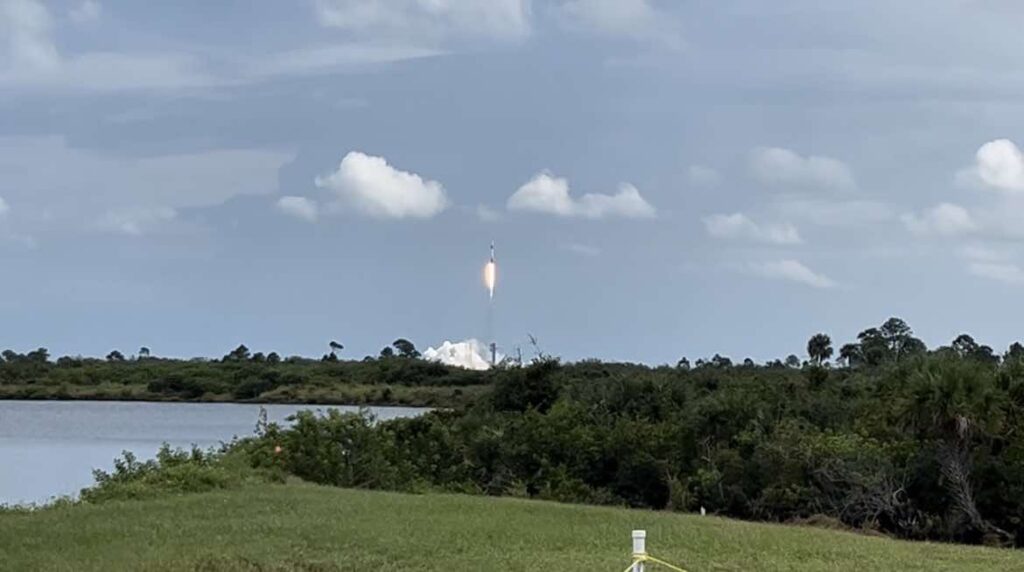KENNEDY SPACE CENTER — After weather delays, SpaceX launched another critical crewed flight into the skies above as spectators across the Space and Treasure coasts looked on. Meteorologists carefully monitored the weather, issuing reports about the partly cloudy skies surrounding the space center right up to the launch.
Crowds at the launch complex could be heard cheering as the two-member Crew-9 mission – one of several involving more than 200 science experiments – jolted into orbit. The launch came days after delays caused by Hurricane Helene’s deadly passage from the Gulf of Mexico into the Florida panhandle.
Video by Nick Samuel
The rocket carrying the Freedom space capsule lifted off at 1:17 p.m., marking SpaceX’s ninth-crew rotation and 10th flight with astronauts, including the Demo-2 test flight. Clouds continued to build, but presented no major issues leading to the countdown with 70 percent of favorable conditions for launch, allowing beachgoers a view south of the Cape.
NASA Astronaut Nick Hague, crew commander, and Roscosmos cosmonaut Alexsandr Gorbunov, mission specialist, launched atop a Falcon 9 rocket on Saturday to the International Space Station for a five-month mission. A sonic boom echoed as the booster rocket touched down at the landing zone at Cape Canaveral Space Force Station.
Video by Nick Samuel
Helene – a Category 4 storm that hit Florida on Thursday and swirled north – caused a minor delay in operations, NASA administrators said during a Friday pre-launch news conference at the Kennedy Space Center.
“The Hurricane Helene effects here were pretty small,” said Ken Bowersox, associate administrator for NASA’s Space Operations Missions Directorate.
NASA leaders say the mission will be memorable because of unique challenges.
The Crew-9 launch comes three months after NASA and Boeing identified technical issues with Boeing’s Starliner, which launched astronauts Butch Wilmore and Suni Williams – with local connections to Florida Tech in south Brevard – to the space station in June. NASA officials said the Boeing spacecraft had helium leaks with the reaction control thrusters, prompting NASA to return the spacecraft back to earth without any crew earlier this month for safety reasons.
“Just three weeks ago, many of our team were working hard to bring Starliner home. I want to take a moment to commend the NASA and Boeing teams for their diligence during the (Boeing) flight test,” said Jim Free, NASA Associate Administrator, during the Friday news conference. “I want to thank SpaceX for getting us here on the verge of the launch. I look forward to everything this crew will accomplish.”
The Crew-9 mission was the first human spaceflight launch from Space Launch Complex – 40. The SpaceX flights normally lift off from Launch Pad 39A.
“We’ve got two pads. We’ve moved to a new launch pad. It’s great to have that flexibility to use 39A or 40 for launches,” Bowersox said. “I’m really happy to see us execute off of either pad.”
Hague, Gorbunov, and the other astronauts aboard the space station will conduct experiments focused on preparing for human exploration beyond low earth orbit and benefiting humanity on earth, NASA officials said. Some of the experiments include observing the impact of flame behavior on earth, studying cells and platelets during long duration spaceflight, and a B vitamin that could reduce Spaceflight Associated Neuro-ocular Syndrome.
Crew-9 originally had two additional members, NASA Astronauts Zena Cardman and Stephanie Wilson, who both were at the Kennedy Space Center on Saturday. NASA changed the crew size so there would be two unoccupied seats on the Freedom capsule, making room for Wilmore and Williams.
“It’s so impressive to see the professionalism of our astronaut team both Nick and Alexsandr, as they’ve dealt with the changes they have to make so they can handle the ascent and prepare to integrate with the new crew,” Bowersox said. “But also Zena and Stephanie, who gave up their seats on their mission. I just want you to know we’re going to find spots for them to fly. We really appreciate how hard it is to give up a seat and wait a bit longer.”
NASA extended Wilmore and Williams’ stay at the space station to eight months, ensuring a safe return back to earth on the Freedom capsule instead of the defective Boeing Starliner. Wilmore and Williams will fly back to earth with Hague and Gorbunov on the Freedom capsule at the end of the mission in February 2025, according to NASA.
NASA plans to launch astronauts around the moon in September 2025 for the Artemis II mission, land the first astronauts near the lunar South Pole for Artemis III in September 2026 and lift astronauts to the Gateway lunar space station in 2028.
More information on the Crew-9 mission can be found here. More information about the Artemis missions can be found here.

